 |
 |
 |
| |
Phenotypic Resistance and Response to Tipranavir, evidence for Hypersusceptibility
|
| |
| |
JD Baxter1, J Schapiro2, CAB Boucher3, J Scherer4, R Bethell5, M Witvrouw5, C Tilke4, DB Hall6
1Cooper University Hospital/UMDNJ-Robert Wood Johnson Medical School,New Jersey,USA; 2National Hemophilia Center,Tel-Hashomer, Israel; 3Erasmus Medical Center,Rotterdam, the Netherlands; 4Boehringer Ingelheim Germany, Ingelheim,Germany;
5Boehringer Ingelheim (Canada) Ltd, Laval,Québec,Canada; 6Boehringer Ingelheim Pharmaceuticals,Connecticut,USA
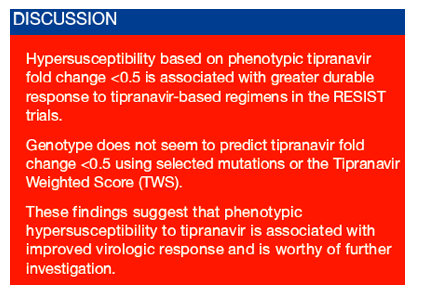
ABSTRACT
Background: Prospective genotypic testing was undertaken to select patients for participation in the ReSIST Phase III trials of tipranavir (TPV) for extensively antiretroviral experienced patients. In the analysis of the relationship between baseline genotype and clinical response that yielded the TPV weighted score (TWS), several mutations predicted better response, suggesting the possibility of
hypersusceptibility. Phenotypic testing was undertaken to explore this possibility.
Methods: Baseline specimens from 930 patients were assayed with the VIRCO Antivirogram or the Monogram Biosciences PhenoSense HIV. Results were categorized with respect to the TPV Fold Change (FC) as <0.5, 0.5 to 1.0, 1.0 to 2.0, and >2.0. Relationships were explored with respect to initial and sustained response stratified by Background Activity Score (BAS) of the background regimen, number of "hypersusceptibility mutations" (24I, 50L/V, 54L, 76V), and overall TWS.
Results: Baseline TPV IC50 FC was distributed with 8.6% <0.5, 17.1% 0.5 to 1.0, 29.2% 1.0 to 2.0, and 45.1% >2.0. Without background support (BAS<0.5), early response and sustained response were associated with phenotypic TPV FC: median week 8 declines of 1.52 log10copies/ml <0.5, 1.01 log10copies/ml 0.5 to 1.0, 0.84 log10copies/ml 1.0 to 2.0, and 0.22 log10copies/ml >2.0, and response <400 copies/ml at week 48 of 37.5% <0.5, 31.3% 0.5 to 1.0, 19.1% 1.0 to 2.0, and 5.3% >2.0. With background support (BAS≥0.5), early response did not show a consistent trend while sustained response was significantly better for FC <0.5 (p<0.001): median week 8 declines of 2.10 log10copies/ml <0.5, 1.98 log10copies/ml 0.5 to 1.0., 2.23 log10copies/ml 1.0 to 2.0, and 1.73 log10copies/ml >2.0, and response <400 copies/ml at week 48 of 64.0% <0.5, 39.6% 0.5 to 1.0, 37.9% 1.0 to 2.0, and 25.7% >2.0. The presence of single TWS hypersusceptibility mutations was not associated with phenotypic hypersusceptibility.
However two or more TWS hypersusceptibility mutations predicted an FC <1.0, with 68% of such specimens <1.0 compared to 24% of specimens with <2 hypersusceptibility mutations.
Conclusions: Phenotypic testing identifies patients who respond well to TPV, adding to genotypic screening results. These findings suggest that phenotypic hypersusceptibility to TPV is associated with improved virologic response and is worthy of further investigation.
INTRODUCTION
Analysis of the ReSIST trials included:
· Development of a background activity score that allowed adjustment for the effect of background regimen, enabling investigation of the relationship between baseline mutations and response to tipranavir.1
· Development of a tipranavir weighted score that could predict response to tipranavir regimens, including mutations with negative scores indicative of better response.2
· Demonstration that the mutations with negative scores (24I, 50L/V, 54L, 76V) contributed to durable clinical response, as well as short-term reductions in viral load.3
Clinical cases have been identified of treatment experienced, multidrug resistant patients for whom tipranavir was selected as part of their antiviral regimen because their genotypic profile included mutations that predict a durable response to tipranavir (24I, 50L/V, 54L, 76V), and they were found to have favorable phenotypic susceptibility to tipranavir.
· TPV IC50 Fold Change of 0.32 with the following mutations: 10I, 13V, 20M, 24I, 33F, 46I, 54V, 62V, 63P, 71I, 76V, 82A, 93L.
· TPV IC50 Fold Change of 0.59 with: 10F, 13V, 24I, 32I, 33F, 46L, 53F/L, 54L, 63P, 74P, 77I, 82A.
Both cases had a full virologic response to their tipranavir-based regimen.
Additional testing of baseline phenotypes from the ReSIST trials was undertaken with the objective of allowing investigation of the relationship between "hypersusceptible" baseline phenotypes and response, as well as the relationship between "hypersusceptible" baseline phenotypes and mutations in the tipranavir weighted score (TWS).
METHODS
Baseline specimens from 930 patients were assayed with the VIRCO Antivirogram or the Monogram Biosciences PhenoSense HIV.
Results were categorized with respect to the TPV Fold Change (FC) as <0.5, 0.5 to 1.0, 1.0 to 2.0, and >2.0.
Relationships were explored with respect to initial and sustained response stratified by Background Activity Score (BAS) of the background regimen for tipranavir-treated patients.
Relationships were explored with respect to number of "hypersusceptibility mutations" (24I, 50L/V, 54L, 76V), and overall TWS for all patients with baseline phenotype available.
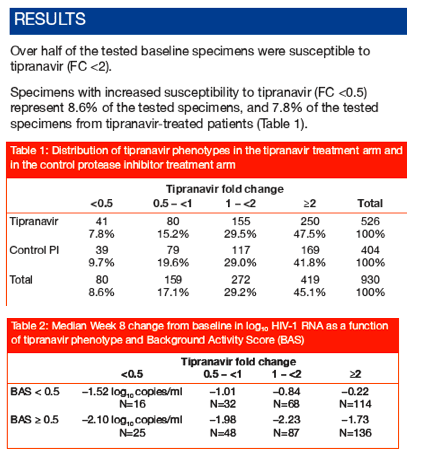
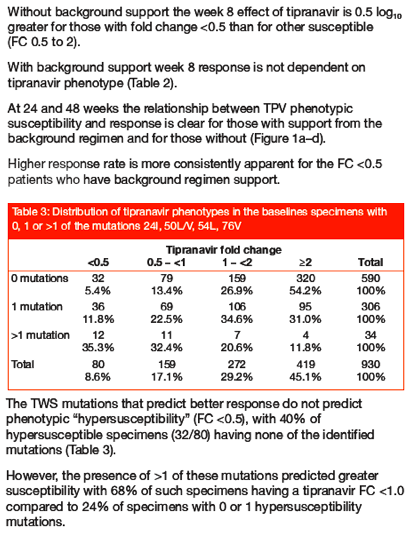

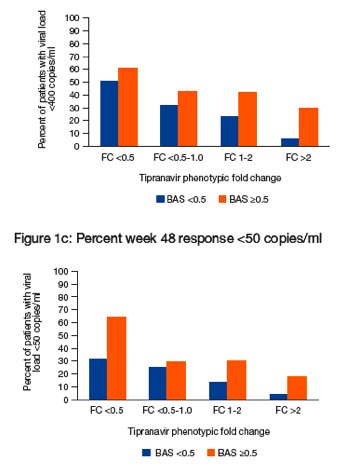
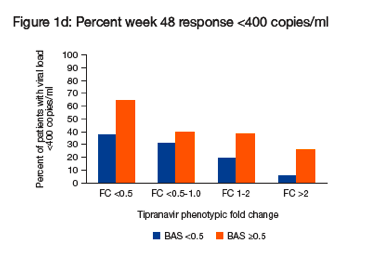
References
1 Development and performance of a trial-specific genotypic sensitivity score based on ReSIST data that incorporates treatment history in addition to predicted susceptibility. Hall DB, Schapiro JM, Boucher CAB, Baxter JD, Piliero P, Scherer J. 2008. Sixth european HIV Drug Resistance Workshop. Budapest, Hungary.
2 Improving the prediction of virologic response to tipranavir: the development of a tipranavir weighted mutation score. Scherer J, Boucher CAB, Baxter J, Schapiro J, Kohlbrenner V, Hall D. 2008. Sixth european HIV Drug Resistance Workshop. Budapest, Hungary.
3 Mutations 24I, 50L/V, 54L and 76V, selected by other protease inhibitors, predict durable response to tipranavir in treatment experienced patients when two or more are present. Hall DB, Baxter J, Schapiro J, Boucher CAB, Tilke C, Scherer J. 2008. XVII International HIV Drug Resistance Workshop. Sitges, Spain.
Acknowledgements
Supported by Boehringer Ingelheim.
Trial clinical monitors: Murray Drulak, Ante
|
| |
|
 |
 |
|
|